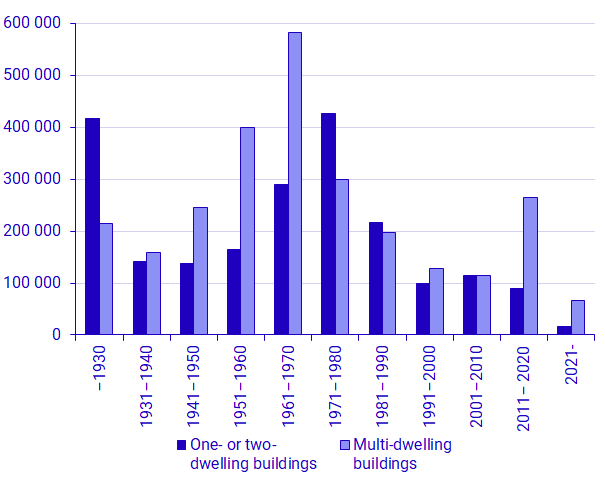Dwelling stock 2022-12-31
Nearly 5.2 million dwellings in Sweden
Statistical news from Statistics Sweden 2023-04-19 8.00
At the end of December 2022 there were 5 158 699 dwellings in Sweden. Among these, 2 125 269 (41 percent) were in one- or two-dwelling buildings, 2 675 269 (52 percent) were in multi-dwelling buildings, 278 546 (5 percent) were in special housing, and 79 615 (2 percent) were in other buildings.
Rented dwellings most common in 258 out of 290 municipalities
In multi-dwelling buildings, rented dwellings is the most common form of tenure, at 58 percent of the total dwelling stock, while owner-occupied dwellings accounted for 42 percent. Rented dwellings were most common in 258 out of the 290 municipalities in Sweden. Only 32 municipalities have more owner-occupied dwellings than rented dwellings. More than half of these municipalities are located in Stockholm County.
Among one- or two-dwelling buildings, ownership rights is the most common form of tenure, at 91 percent. Rented dwellings and owner-occupied dwellings in one- and two-dwelling buildings accounted for 4 and 5 percent, respectively.
Housing cooperatives most common owners of multi-dwelling buildings
With regard to dwellings in multi-dwelling buildings, about 42 percent are owned by housing cooperatives, 26 percent are owned by municipal housing companies, and 23 percent are owned by Swedish joint-stock companies. The remaining 9 percent are owned by natural persons and other owners.
With regard to one- or two-dwelling buildings, the vast majority, 91 percent, is owned by natural persons and only 5 percent are owned by housing cooperatives.
Dwellings’ size and age
The average dwelling in multi-dwelling buildings is a flat with two rooms and a kitchen, followed by three rooms and a kitchen. These two types account for 68 percent of the housing stock in multi-dwelling buildings.
The average dwelling in multi-dwellings buildings is 67 square metres, while in one- or two-dwelling buildings, the average size is 122 square metres.
| Size of dwelling | Number of dwellings | Average size in square metres |
|---|---|---|
| Dwellings without kitchen equipment | 1 808 | 32 |
| 1 room and kitchen | 321 910 | 39 |
| 1 room and kitchenette | 117 631 | 30 |
| 2 rooms and kitchen | 978 838 | 59 |
| 2 or more rooms with kitchenette | 46 650 | 48 |
| 3 rooms and kitchen | 833 288 | 78 |
| 4 rooms and kitchen | 294 096 | 98 |
| 5 rooms and kitchen | 56 885 | 123 |
| 6 or more rooms and kitchen | 11 407 | 172 |
| Data missing | 12 756 | .. |
| Total | 2 675 269 | 67 |
Just over 933 000 (44 percent) of Sweden’s one- or two-dwelling buildings were built between 1961 and 1990. However, one in five (corresponds to 20 percent) one- or two-dwelling buildings were built as early as before 1931. With regard to multi-dwelling buildings, nearly 1 283 000 dwellings (or 48 percent) were built between 1951 and 1980.

Special housing
There are 278 546 dwellings in total in special housing, consisting of 146 140 special housing for elderly/disabled, 112 444 housing for students, and 19 962 other special housing. The average size of a flat in a retirement home is 39 square metres, while the average size of a student flat is 28 square metres. Most number of student housing is located, naturally, in the major university towns.
| Municipality | Number of dwellings |
|---|---|
| Stockholm | 13 714 |
| Uppsala | 12 998 |
| Göteborg | 12 064 |
| Lund | 10 019 |
| Umeå | 7 445 |
| Linköping | 5 396 |
| Växjö | 4 101 |
| Jönköping | 3 404 |
| Örebro | 3 266 |
| Malmö | 3 146 |
Definitions and explanations
The statistics are based on the apartments register, which is a national register of all dwellings in Sweden. This register is managed by Lantmäteriet (the Swedish mapping, cadastral and land registration authority). Statistics Sweden receives data from Lantmäteriet for the production of current household and housing statistics.
One- or two-dwelling buildings refers to detached one- and two-dwelling buildings, as well as semi-detached, row and linked buildings.
Multi-dwelling buildings refers to buildings with three or more apartments, including balcony access housing.
Other buildings refers to buildings that are not intended for residential purposes, but that nonetheless contain regular apartments, for example, buildings intended for business or public activities.
Special housing refers to dwellings for the elderly/disabled, student housing, and other special housing.
The type of tenure of the apartments is based on ownership, rather than residents’ use of the apartments.
Feel free to use the facts from this statistical news but remember to state Source: Statistics Sweden.
